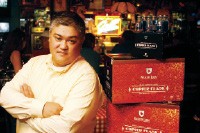Memphis’ characteristic autumn tease was definitely over by 10 o’clock Saturday morning. The Memphis Farmers Market downtown was full, and 40 people were there as part of the local American Institute of Architects’ (AIA) annual Chalk Art Festival.
Held in conjunction with the Memphis Heritage Foundation, the festival was part of Architecture Month. Teams created their best tribute to Memphis architecture in five-by-five-foot squares taped off on the ground. The Art Center on Union supplied the chalk, and the teams, already hard at work, consisted of families or members of architecture firms.
“We’re here to have fun,” said architect Rebecca Lee of Askew, Nixon, and Ferguson. “It’s nice to spend the day out.”
Throughout September’s Architecture Month, the Memphis AIA and Memphis Heritage have hosted a series of lectures and films to help Memphians see the city as a growing organism that requires thoughtful planning as well as aesthetic creativity.
“When there are tourists looking for Memphis history, they’re usually just shown Graceland and Beale Street,” said June West, executive director of Memphis Heritage. “There’s a lot a person can see in Memphis that we never show them.”
Under the morning sun, the artists drew and colored with their chalk, racing to finish before the noon deadline. The pieces were judged in four categories: teams, families, individuals, and Best in Show.
All over the pavement, the designs grew from simple sketches and outlines, slowly taking form and color. The pieces included one in which buildings played guitar, a vegetable motif by members of the Farmers Market, and a large likeness of Family Guy fussbudget Stewie Griffin warning the world to love architecture or face the consequences.
“We wanted to do something original,” said Mario Walker of Self Tucker Architects, who, along with associate Rodrigo Garcia, created the Family Guy entry. “We knew everyone else was going to do something appropriate.”
Last year’s winner in the team category, Fleming Associates once again took home bragging rights, winning Best in Show. Their design was a view of a Redbirds game from the right-field bleachers at AutoZone Park.
“Nine out of 10 of our favorite things to do in Memphis involve eating and drinking, and this was a scene that combines the two,” said Fleming’s Richard Wiggs, who, along with Debb and Bob Ross, created this year’s grand winner. “Getting dirty is all part of the fun.”
 Justin Fox Burks
Justin Fox Burks